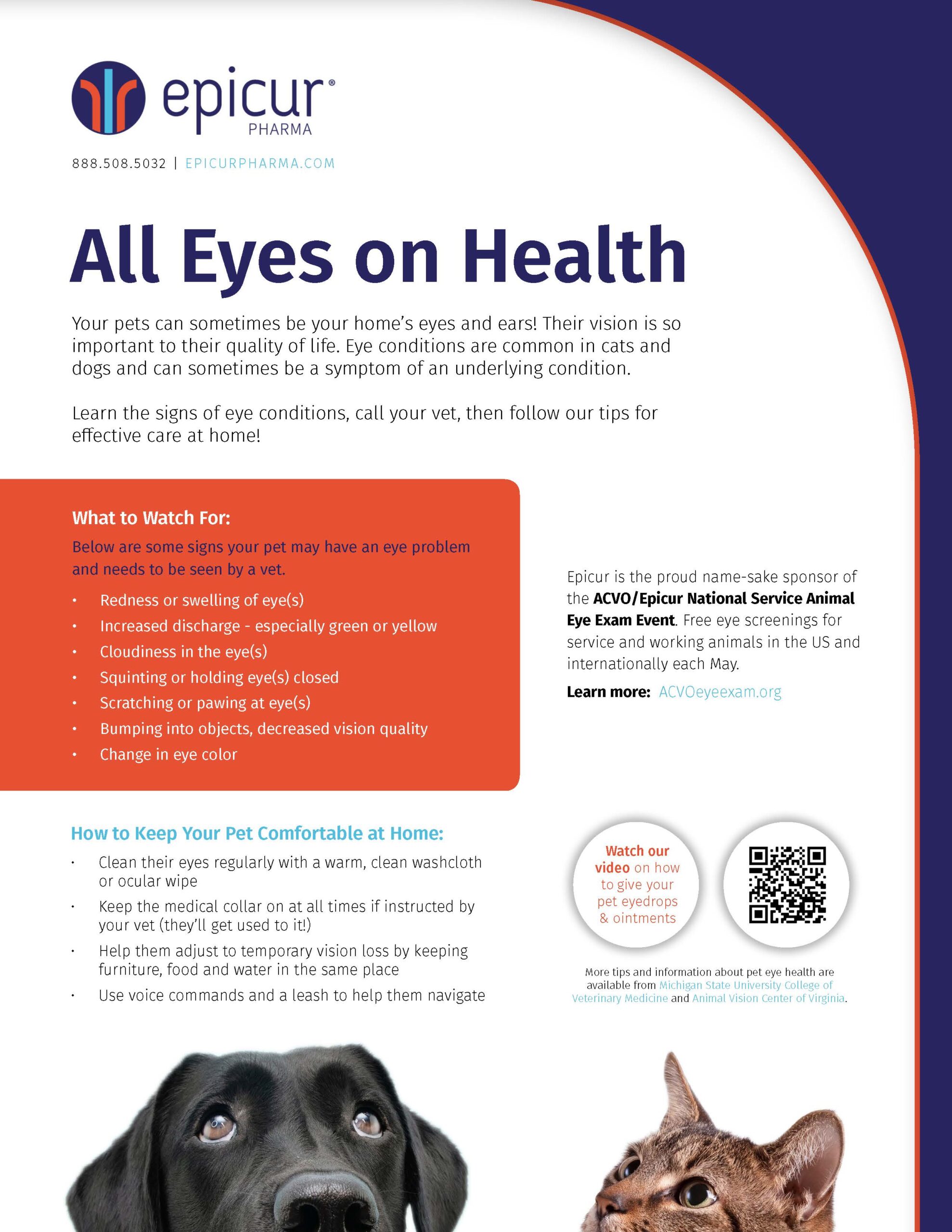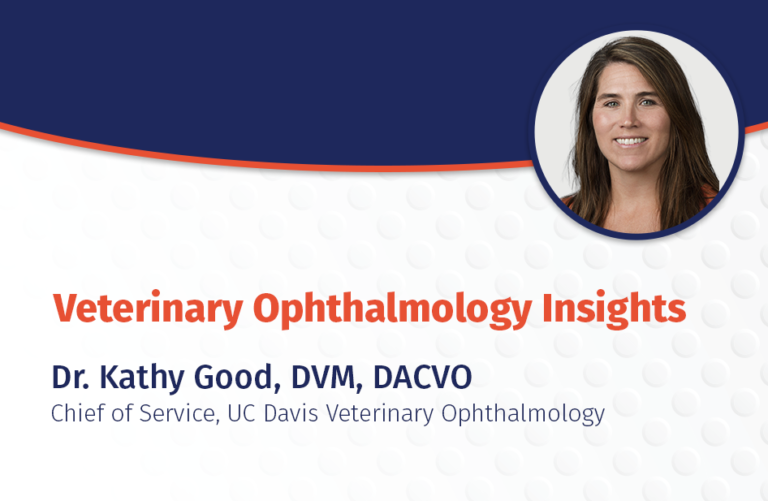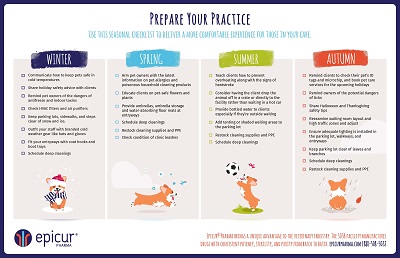Dr. Kathy Good, DVM, DACVO, oversees one of the largest ophthalmology departments at a world-leading veterinary school. But what matters to her most are the opportunities her department provides to its students, residents, and the community.
We sat down with Dr. Good to learn why veterinary ophthalmology is such a unique and loved specialty and how giving back reminds veterinary professionals of the reason they chose this field.
How did you end up in the veterinary field?
I was the typical child who absolutely loved animals and I was very much science and math-oriented in high school. When I applied for college I thought, “Oh, I love math so much, I’ll be an accountant.” But after one quarter as an Economics major and its supply and demand curves, I realized it wasn’t for me! I quickly changed my major to Biology. From that point on I pursued my passion for veterinary medicine and was fortunate to get into UC Davis.
When did you realize you wanted to specialize in veterinary ophthalmology?
During my veterinary school training at UC Davis, I fell in love with ophthalmology. I read the course textbook front to back when it wasn’t required and came in for after-hours emergencies just to observe. I had great professors when I was a student (Steve Hollingsworth and Ned Buyukmihci) who were passionate about the profession which excited me that much more. It was then that I knew that I wanted to pursue this specialty as a lifelong career. I was fortunate to obtain an internship at the University of Florida which had an amazing ophthalmology service and awesome ophthalmologists as mentors (Dennis Brooks, Kirk Gelatt, and Stacy Andrew).
After my internship, I returned to UC Davis to complete my residency in Comparative Ophthalmology and could add one more esteemed mentor to my list—David Maggs. Following my residency, I was in private practice for about seven years. I loved private practice and the people that I worked with, but I missed the teaching part of the profession that I really enjoyed when I was an intern and resident. So, I again returned to UC Davis and have been here ever since.
Other ophthalmologists we’ve spoken with say it’s the intricacy of ophthalmology that they love the most. Is it the same for you?
Absolutely, I completely agree. The eye is obviously a very small structure with lots of tiny parts. We have the fortune of being able to do lots of delicate procedures where precision is absolutely crucial for a successful outcome. I have a type-A personality, so I think that’s part of what drew me to this specialty! You don’t have a big margin for error when you’re evaluating and operating on such tiny structures. The other obviously rewarding part of this specialty is being able to restore vision in a blind animal. It’s pretty amazing witnessing an animal “see” its human companion for the first time in a while.
Are you able to restore sight in most of the cases you treat?
This typically depends on the disease process and chronicity of the disease. In many situations, if we can diagnose a patient in the early stages of most conditions, we can preserve and/or restore vision. Cataracts are a great example of this. We perform cataract surgery in animals similar to how it is done in people, and we have really good success at restoring vision. Despite our best efforts, however, there are also diseases that unfortunately carry a poor prognosis for return of vision, regardless of how hard we try. For many of those conditions, we focus on keeping the animal comfortable despite a non-visual eye. In some situations, a patient may require having their eye removed if it is blind and persistently painful, or if we are worried about the eye having cancer.
Want more animal eye health resources?
Check out our pet eye health page and get our free eye health handout—it’s great for pet owners and vet clinics!

We’d love to hear more about your role as UC Davis’ Chief of Service of Veterinary Ophthalmology.
I have been really fortunate to be the Chief of Service of our Ophthalmology Department for the past six years. We are one of the largest ophthalmology groups worldwide, and I work with the most amazing people that I get to call colleagues as well as friends. Our group consists of ophthalmologists that span from purely research-oriented to purely clinic-oriented, and everything in between. My amazing colleagues consist of Drs. David Maggs, BVSc (hons), DACVO; Chris Murphy, DVM, PhD, DACVO; Sara Thomasy, DVM, PhD, DACVO; Brian Leonard, DVM, PhD, DACVO; and Bianca Martins, DVM, PhD, DACVO.
As Chief of Service, I’m responsible formany of the administrative and personnel aspects of the job in addition to my clinical responsibilities. A lot of the service-specific administrative duties are similar to what a private practice owner does on a daily basis, plus there are hospital-wide and University-specific topics that occasionally come up requiring Chiefs from all hospital services to meet and discuss. My role as Chief of Service has been a great way to engage with the entire hospital and give back to our Service in addition to taking care of our clinical patients.
What kind of patients do you see most often and what other job duties do you have at the University?
In the clinic, we see animals of all species. That is one of the fun aspects of our specialty. Given that UC Davis has a large Exotic Companion Animal Service, we get to see lots of birds, reptiles, rabbits, guinea pigs and even fish. We also work closely with our local zoos and wildlife rehabilitation centers. But I must admit that I spend most of my day evaluating dogs and cats and an occasional horse. We have a large equine caseload at UC Davis, but since Dr. Bianca Martins joined us from Illinois, she has been our primary Equine Ophthalmologist which has been great. I also do some didactic teaching with lectures in the classroom, but most of my teaching is to fourth-year veterinary students as well as our residents in the clinic. My position does not carry a large research component, but the studies that I am involved with are typically clinically oriented versus bench-top research. I leave the bench top science to my amazing colleagues who are much smarter than me!
UC Davis often ranks as the #1 veterinary school in the world. How does the university maintain such a high level of distinguishment?
UC Davis is truly a tremendous institution and that high level of distinguishment that you refer to can only be maintained by the hard work and dedication of the people who make up this university. The teaching curriculum is rigorous and creative, the research being performed is cutting edge, our research publications are globally driving patient management decisions, public outreach is at an all-time high, close working relationships are fostered between our faculty and clinician-scientists at the UC Davis School of Medicine, and our teaching hospital is providing daily state-of-the-art care to companion animals, wildlife, and zoo animals well beyond the borders of California. It is definitely a great place to be.
How does such a valuable veterinary program influence your ophthalmology department?
Working within a veterinary program that has such a high level of research production and provides such an advanced level of medical and surgical care simply encourages everyone to continue to work at the same advanced level with the common goal of advancing our veterinary profession. This holds true for our Ophthalmology Department as well. We have one of the leading veterinary vision science programs in the world and the University is extraordinarily supportive of our efforts to maintain this program at the forefront.
You mentioned that you have more involvement in the clinical side. How does a veterinary practice at a teaching university differ from a private practice an owner would bring their pets to?
The main difference is the fact that the University is a teaching facility for students within the veterinary medicine curriculum. Veterinary students come through the teaching hospital in their fourth year and learn how to diagnose patients and treat them in real-life situations.
Here, it’s usually the students who obtain the initial patient history from the client and perform the initial eye examinations. They then relay the client’s history and what they’re seeing to a faculty member like myself or one of our residents in training. After their exams, we ask the students a few questions such as:
- What abnormalities are you seeing?
- What do you think is going on?
- How do you want to treat it?
- What is the prognosis for the eye? The patient?
Then we do our examination and either confirm the student’s observations or point out things maybe they didn’t see. After this second exam, we have an open discussion:
- Did the student come to the right conclusion?
- Based on what we see, is this the right treatment? Is there more than one treatment option?
- If so, how do you present those options to a client?
- How do you help them make the decision as to what to do next?
In some regards we’re like a private practice, but because we have a heavy teaching component for the students we don’t typically get through as many cases a day as a private practice. We spend more time on each patient so that all students can learn how to do a proper eye exam and can identify the most common eye diseases that they will see in practice. That holds true for residents, too. They are in training to be specialists in ophthalmology, so we spend time teaching them advanced examination and surgical skills.
The ACVO/Epicur National Service Animal Eye Exam event recently wrapped up and I know your school often volunteers. How does participating in this event create unique learning opportunities for ophthalmology students?
The event is a great opportunity for students to do an eye exam and for us to walk them through what they’re seeing. Most of the time (outside of the event) we see patients with severe eye diseases, so the event is a time we’re hopefully seeing more normal eye exams. This helps reaffirm for the students what normal should look like. Plus, most of these patients are really well-behaved and very responsive animals because they need to be for their jobs. That typically makes them very cooperative for their exams. And I love that the students can see that there are ways to give back to the community after they graduate and start their careers in practice.
For you personally, why are events like this so important in the veterinary industry?
For me, it’s being involved in a service that gives back to the community. And with how hectic everybody’s lives are these days, and it certainly seems amplified these last few years, it’s so easy to get wrapped up in all the things that we need to do for ourselves and our work. So, this is really a grounding opportunity that gives a bigger picture as to why we do what we do.
Most of us entered this profession because we love animals, and we want to do right by them. The ACVO/Epicur event really accomplishes that, in addition to helping the individual who that animal is serving so selflessly. We get to play a big part in keeping them healthy and therefore keeping those that they serve healthy. It’s also really rewarding just to hear how extraordinarily grateful the clients are that this service is offered.
Do you have any patient stories, from the event or in general, that stay with you?
Let’s see, I’ve seen dogs who serve hearing-impaired individuals, therapy dogs that go to convalescent homes, and ones who have been reading buddies for children at local libraries. I saw a really cool search and rescue Border Collie this year as well. As you can see, their jobs span a wide range of important duties.
He wasn’t my patient, but my colleague David Maggs evaluated a cool bloodhound during the event named “Bootstrap Bill.” We are big Pirates of the Caribbean fans in my house, so I loved his name!
What pets does your family have right now?
We have two dogs and a cat. We had a rat, but she passed away after having her fifth tumor removed. Our last rat lived to be about five years old—the average is two or three, I think! My husband is a veterinarian as well and it’s hard for him to say no to going that extra mile when our daughters ask him.
Rats are cute little pets. I wasn’t sure at first with their tails, but they’re actually very sweet and very smart. You can train them to do tricks. The hardest part of having one as a pet is trying to teach our girls which rats belong in the house and which ones don’t!
Veterinary professionals always seem to have the most interesting pets! I don’t think a rat would be most people’s first choice.
Back to medicine – are there any trends or interesting projects you’re looking forward to in veterinary ophthalmology?
We’re involved with so many exciting projects and clinical trials. My colleagues at UC Davis as well as many others within the ACVO are continuously working on vision-saving techniques and therapies. The genetics of ocular disease is a big area of research at the moment which is exciting from the perspective of lessening the propagation of certain vision-impairing and painful conditions in high-risk breeds.
And of course, events like the ACVO/Epicur National Service Animal Eye Exam Event are really exciting to be a part of-it’s rewarding to optimize vision in patients who care for human beings in many different capacities.
Any tips or advice for clients to help them maintain healthy eyesight in their animals?
Mostly, be aware of the changes that indicate an eye problem (cloudiness, redness, discharge from the eyes, squinting, vision impairment, etc.) and act fast. Ocular disease can progress quickly, so oftentimes the key to a successful outcome (including maintenance of normal vision) is early intervention. In addition, knowing whether the particular breed of animal that they have, even if they’re a mixed breed, might be prone to inheriting and hence developing a vision-threatening eye condition can likely help a client recognize a problem much sooner.
More Animal Health Resources
Download our printable tip sheets, guides, and eBooks to share in your practice, and check out our pet owner resources for more educational content to share with your clients!






